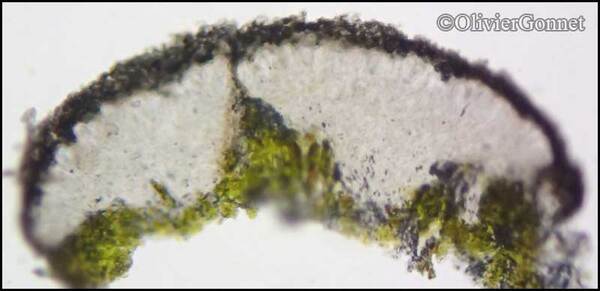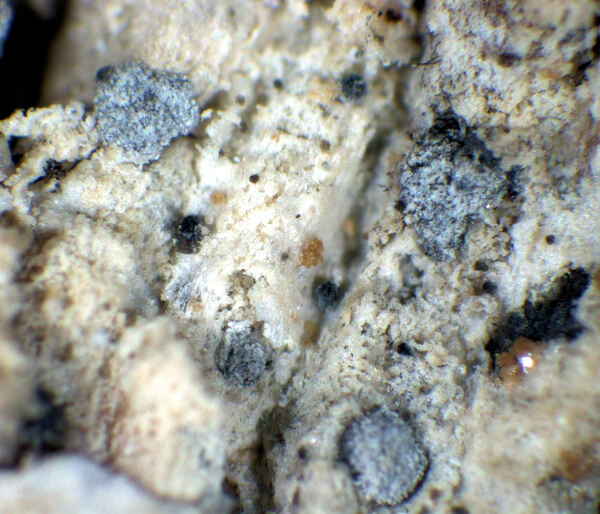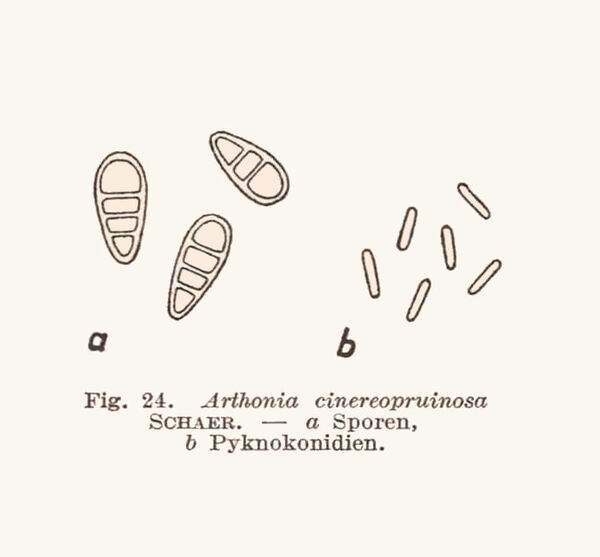Leprantha cinereopruinosa (Schaer.) Körb.
Syst. Lich. Germ.: 296, 1855.. Basionym: Arthonia cinereopruinosa Schaer. - Enum. Crit. Lich. Eur.: 243, 1850.
Synonyms: Arthonia lilacina (Ach.) Körb.; Pyrenotheca stictica Fr.; Trachylia cinereopruinosa (Schaer.) A. Massal.
Distribution: N - Frl, Ven (Nascimbene & Marini 2010), Lomb. S - Camp, Bas.
Description: Thallus crustose, thinly episubstratic, 50–90 μm thick, smooth, continuous, yellowish white- to grey-white-pruinose, the pruina soluble in K, sometimes delimited by a brownish prothallus, amyloid. Apothecia arthonioid, at first semi-immersed, then slightly projecting, rounded, elliptical or weakly lobed, (0.2-)0.5-0.7(-1) mm across, with an initially flat but soon convex to hemispherical, dark grey to black but heavily bluish-pruinose disc, without a distinct proper margin. Proper exciple poorly developed, of brown hyphae resembling paraphysoids, 10-40 μm wide; epithecium brownish, 10-15 μm high; hymenium colourless or yellowish, (40-)50-70(-80) µm high, hemiamyloid, I+ red, K/I+ blue; paraphysoids slender, c. 1 µm thick, richly branched and anastomosing, the apical cells 2-3 μm wide, with a distinct brown cap; hypothecium colourless or very pale yellowish brown, 50-90 μm high. Asci (6-)8-spored, broadly clavate to subglobose, semi-fissitunicate, with a large apical dome and a distinct ocular chamber, the wall not laterally thickened, the tholus without horizontal layers, approaching the Arthonia-type. Ascospores (2-)3-4(-5)-septate, narrowly ovoid, pointed at one end, with the opposite terminal cells distinctly enlarged, hyaline or pale brown when overmature, (11-)12-15(-18) x 4-6(-7) µm, straight, without a distinct perispore. Pycnidia numerous, black, more or less immersed, c. 0.1 mm across, the wall reddish brown. Conidia bacilliform, straight, 3-5(-6) x (0.5-)1(-1.5) µm. Photobiont trentepohlioid. Spot tests: thallus K- or K+ faintly yellow, C-, KC-, P+ yellow-orange. Chemistry: thallus with psoromic acid.Note: a mild-temperate species found on smooth bark of deciduous trees in dense humid forests. It is included in the Italian red list of epiphytic lichens as “Critically Endangered” (Nascimbene & al. 2013c). The old records from Campania and Basilicata (see Nimis 1993: 74) need re-confirmation.
Growth form: Crustose
Substrata: bark
Photobiont: Trentepohlia
Reproductive strategy: mainly sexual, or asexual by conidia and thalloconidia
Commonnes-rarity: (info)
Alpine belt: absent
Subalpine belt: absent
Oromediterranean belt: absent
Montane belt: extremely rare
Submediterranean belt: extremely rare
Padanian area: absent
Humid submediterranean belt: extremely rare
Humid mediterranean belt: absent
Dry mediterranean belt: absent

Predictive model
Herbarium samples

Courtesy Danièle et Olivier Gonnet - Source: https://www.afl-lichenologie.fr/Photos_AFL/Photos_AFL_L/Texte_L_5/Leprantha_cinereopruinosa.htm
France, 3/10/2014 - Bonifacio - Corse
Growth form: Crustose
Substrata: bark
Photobiont: Trentepohlia
Reproductive strategy: mainly sexual, or asexual by conidia and thalloconidia
Commonnes-rarity: (info)
Alpine belt: absent
Subalpine belt: absent
Oromediterranean belt: absent
Montane belt: extremely rare
Submediterranean belt: extremely rare
Padanian area: absent
Humid submediterranean belt: extremely rare
Humid mediterranean belt: absent
Dry mediterranean belt: absent

Predictive model
| Herbarium samples |

 INDEX FUNGORUM
INDEX FUNGORUM
 GBIF
GBIF
 DOLICHENS
DOLICHENS





